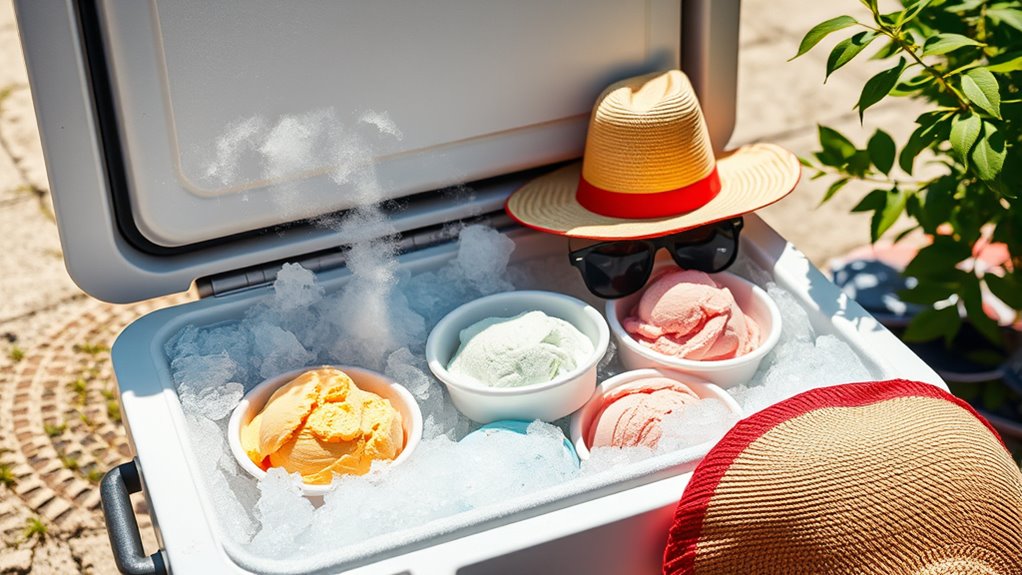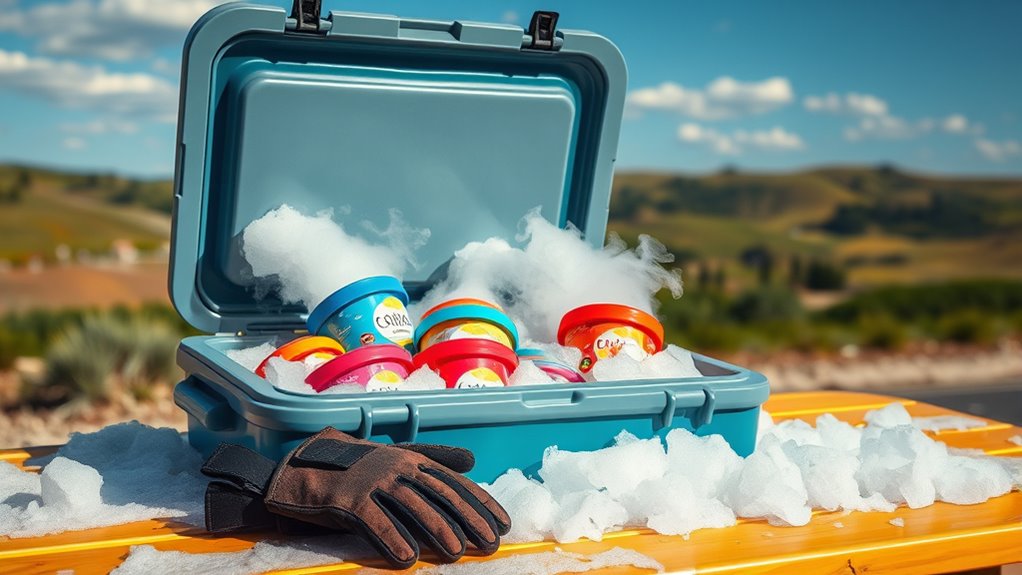When traveling with ice cream, pack it right to keep it frozen. First, freeze it solid and use a sturdy insulated container, like a styrofoam cooler. For extended cold, add 2-3 pounds of dry ice. Don’t forget to wear gloves when handling dry ice and guarantee proper ventilation. Fill gaps with crumpled newspaper to minimize air circulation. Pay attention to your travel method, as air and road transport have different guidelines. Discover more tips to guarantee a perfect trip!
Key Takeaways
- Pack ice cream immediately after freezing in a well-insulated cooler to maintain its texture and prevent melting during transport.
- Use 2-3 pounds of dry ice for a half-gallon or gallon of ice cream to extend coldness, adjusting the ratio for longer shipping durations.
- Ensure proper ventilation when transporting dry ice, and always wear gloves to prevent frostbite while handling it.
- Minimize cooler opening time and fill gaps with crumpled newspaper or foam padding to maintain a stable cold temperature.
- Check airline policies on dry ice limits and prepare for road travel’s flexibility with packing and monitoring ice cream during the journey.
Importance of Properly Freezing Ice Cream

When you’re planning to transport ice cream, the importance of properly freezing it can’t be overstated. Properly freezing ice cream solidifies its texture and prevents melting during transport, ensuring it retains its quality and flavor.
Pack your ice cream straight from the freezer without letting it temper, so it stays in its best frozen state before travel. A fully frozen state is essential; even slight melting can compromise texture and lead to undesirable ice crystals upon refreezing.
To keep ice cream at its best, maintain a temperature at or below 0°F (-18°C) during transport. The ideal packing time is immediately after freezing, as this minimizes exposure to warmer temperatures, maximizing preservation and ensuring you enjoy that creamy consistency later.
Choosing the Right Insulated Container

Choosing the right insulated container is crucial for keeping your ice cream frozen during travel.
Opt for sturdy plastic or styrofoam coolers, as they offer effective insulation and are easy to find at grocery stores. Make sure the container has enough space to pack your ice cream without being oversized, which can compromise temperature retention due to excess air.
For improved insulation, crumple newspaper or use other insulating materials inside the cooler to reduce air circulation. If you’re using dry ice, select a container that accommodates it well; around 2-3 pounds is suitable for half-gallon or gallon sizes of ice cream. Additionally, consider that ice cream consumption increases during summer months, which may influence how long you need to keep your ice cream frozen.
Finally, pack immediately after freezing and minimize the time the cooler remains open to maintain ideal coldness.
Utilizing Dry Ice for Extended Coldness

When you’re traveling with ice cream, using dry ice is a game changer for keeping it frozen.
Aim for 2-3 pounds of dry ice for a half-gallon or gallon to guarantee it stays solid for a few hours.
Just remember to handle it safely with gloves and guarantee proper ventilation during transport.
Optimal Dry Ice Amounts
To keep your ice cream frozen during transport, aim for 2-3 pounds of dry ice for every half-gallon or gallon of ice cream. This guarantees ideal dry ice amounts to maintain freezing temperatures.
If you’re shipping ice cream for 1-2 days, a 1:1 ratio of dry ice to ice cream works well. For 2-3 day shipping, increase it to 1.5:1.
Remember, a 5-pound block lasts about 24 hours, while a 10-pound block can last up to 48 hours, so choose accordingly based on your travel duration.
Always take precautions when handling dry ice; use gloves to prevent frostbite and guarantee proper ventilation to avoid CO2 buildup, especially if you’re traveling by road.
Safe Handling Practices
Although handling dry ice is crucial for keeping your ice cream frozen during transport, it’s important to prioritize safety.
Always wear gloves when handling dry ice to prevent frostbite, as direct contact can cause serious skin injuries.
When transporting, guarantee proper ventilation by cracking windows in your vehicle to avoid carbon dioxide buildup, which can pose health risks.
If you’re flying, confirm with your airline that you can bring dry ice, keeping within the five-pound limit per passenger, and be ready to inform TSA agents about regulations.
Finally, store dry ice in insulated containers like styrofoam coolers to minimize heat transfer, maximizing its effectiveness in keeping your ice cream perfectly frozen.
Ensuring Ventilation When Transporting Dry Ice

When you’re transporting dry ice, ensuring airflow is essential for your safety.
Crack the windows and store it in the trunk to prevent carbon dioxide buildup, which can be dangerous.
Always keep an eye on the dry ice and use a cooler that allows for off-gassing to maintain proper ventilation.
Importance of Airflow
Ensuring proper airflow is essential for safely transporting dry ice, as it helps prevent the dangerous buildup of carbon dioxide (CO2) gas.
Always place your dry ice in well-ventilated areas of your vehicle, like the trunk, and avoid passenger compartments. Cracking the windows or using a vehicle designed for proper airflow can further reduce CO2 accumulation risks.
When packing, opt for insulated containers with airflow openings; these will help manage CO2 release while keeping your ice cream cold.
Remember to monitor your dry ice amount, keeping it under 5.5 pounds to comply with safety regulations.
Safe Dry Ice Handling
Proper handling of dry ice is key to safely transporting your ice cream.
When using dry ice for ice cream storage, always guarantee proper ventilation in your vehicle. Cracking the windows keeps CO2 from building up, preventing potential hypoxia. Avoid placing dry ice in passenger compartments, as the gas can pose health risks in confined spaces.
Always wear gloves when handling dry ice to protect your skin from frostbite. If you’re flying, remember there’s a five-pound limit per passenger for dry ice, so check with your airline for specific policies.
For shipments over 5.5 pounds, be aware of regulations that may require special packaging and labeling.
Keep safety a priority while enjoying your delicious ice cream!
Additional Layers of Insulation

Adding extra layers of insulation can make a noticeable difference in keeping your ice cream frozen during travel. Start by wrapping your insulated container in blankets or towels, which greatly enhances its temperature retention.
Consider using gel packs alongside dry ice; the gel packs absorb ambient heat while dry ice keeps everything well below freezing. If you’re on a short trip, insulated bags designed specifically for food transport can provide that additional layer of protection, ensuring your ice cream stays frozen longer.
Fill any gaps in your cooler with crumpled newspaper or foam padding to minimize air circulation, further insulating your ice cream and helping it stay at the perfect temperature until you reach your destination.
Wrapping Ice Cream to Prevent Frost Formation

To keep your ice cream smooth and free from frost, wrapping it properly is essential. Start by using plastic wrap to cover the surface of the ice cream directly. This barrier minimizes air exposure, which is a primary cause of frost formation.
After wrapping, place the ice cream in airtight containers designed for freezing to maintain its texture and prevent ice crystals. Avoid Tupperware bowls, as they can let air in and contribute to frost.
For longer storage, consider double-wrapping your ice cream with both plastic wrap and aluminum foil. This extra layer enhances protection against moisture and air infiltration, ensuring your ice cream stays fresh and delicious throughout your travels.
Timing Your Ice Cream Packing

After wrapping your ice cream to prevent frost formation, timing your packing becomes essential for maintaining its quality. Confirm your ice cream is completely frozen solid before packing. Pack it immediately after removing it from the freezer to avoid any temperature rise. If you’re traveling by air, check airline policies regarding dry ice, adhering to the five-pound limit per passenger. Avoid letting your ice cream temper; it should go straight from the freezer into your cooler. Consider buying dry ice close to your departure time to maximize its effectiveness in keeping your ice cream frozen during transit.
| Tip | Action |
|---|---|
| Packing Timing | Pack immediately after freezer removal |
| Check Policies | Confirm airline rules on dry ice |
| Temperature Control | Avoid tempering; pack straight from freezer |
| Dry Ice Purchase | Buy close to departure for best results |
| Frozen State | Confirm ice cream is solid before packing |
Transporting Ice Cream by Air vs. Road

Whether you’re flying or driving, transporting ice cream requires careful planning to keep it frozen during your journey.
Transporting ice cream demands thoughtful preparation, whether you choose to fly or drive, to ensure it stays frozen throughout your trip.
When flying, check your airline’s policies on dry ice, as you’re limited to five pounds per passenger. Always handle dry ice with gloves and guarantee proper ventilation in the cabin to prevent CO2 buildup.
On a road trip, you have more flexibility; pack dry ice in a well-ventilated cooler, guaranteeing safety from suffocation risks. A five-pound block of dry ice can keep your ice cream frozen for about 24 hours, making air travel viable.
However, with effective insulation, you can maintain ice cream at home for longer durations on the road, allowing for a more leisurely trip.
Safety Precautions When Handling Dry Ice

Transporting ice cream safely with dry ice involves understanding the safety precautions necessary to handle this extremely cold substance.
Always wear gloves when handling dry ice to prevent frostbite, as its temperature is a shocking -78.5ºC (-109.3ºF). Use insulated containers to keep the dry ice secure and to avoid direct contact with skin or sensitive materials.
Ascertain proper ventilation during transport, especially if you’re carrying more than 5.5 lbs, as it sublimates into carbon dioxide gas, which can cause hypoxia in enclosed spaces.
Store dry ice in a well-ventilated area to allow safe off-gassing, preventing pressure build-up.
Finally, always follow local regulations regarding dry ice transport, particularly when flying, as airlines often limit the amount allowed per passenger.
Frequently Asked Questions
How Do You Pack Ice Cream for Travel?
To pack ice cream for travel, make sure it’s frozen solid before you start.
Use a cooler that fits your pints snugly and add crumpled newspaper for insulation if needed. Incorporate dry ice—about 2-3 pounds for a half-gallon—to keep it frozen.
If you’re flying, check your airline’s dry ice policy, and always handle it with gloves.
Pack quickly to prevent melting, keeping the ice cream at a low temperature throughout your journey.
How to Transport Ice Cream for 6 Hours?
To transport ice cream for 6 hours, you’ll need a high-quality insulated cooler and some dry ice—about 2-3 pounds should do.
Make sure your ice cream is completely frozen before packing. Wrap the container in plastic wrap or place it in an insulated bag to keep it cold.
Add gel packs or frozen items around it for extra cooling. Don’t forget to ventilate your vehicle to safely manage the dry ice.
What Is the Best Packaging for Ice Cream?
When you think of ice cream melting in the sun versus staying frozen in a cooler, the right packaging makes all the difference.
For the best results, use high-performance insulated boxes or insulated pouches designed specifically for shipping. These options maintain temperatures below 0°F, ensuring your ice cream arrives intact.
Pair them with dry ice at the recommended ratios, and you’ll protect your delicious treat from the heat and keep it creamy.
Can You Go Through TSA With Ice Cream?
Yes, you can go through TSA with ice cream, but you need to follow a few rules.
If it’s frozen solid, you’re good to pack it in your carry-on. Just remember, if it’s over 3.4 ounces, it’ll need to go in checked luggage.
If you use dry ice to keep it frozen, be ready to explain the five-pound limit to TSA agents, as they mightn’t know the regulation.
Conclusion
So, you’ve gone through all the trouble of packing your ice cream perfectly, only to find it melting into a sad puddle by the time you reach your destination. Ironically, all that preparation might make you appreciate the simple joy of a soft-serve cone at a roadside stand even more. Next time, maybe just embrace the chaos of travel and indulge in the moment—because ice cream’s true beauty lies in its deliciously fleeting nature. Enjoy the mess!










